Goalkeeper (association football)
-KsFz3s7OC3jwiCxZkjvRCFlOYt14Si)
Goalkeeper (association football)
-KsFz3s7OC3jwiCxZkjvRCFlOYt14Si)
The goalkeeper, often shortened to keeper or goalie, is one of the major positions of association football. It is the most specialised position in the sport. The goalkeeper's primary role is to prevent the opposing team from scoring (moving the ball over the defended goal-line within the frame of the goal). This is accomplished by the goalkeeper moving into the path of the ball and either catching it or directing it away from the vicinity of the goal line. Within the penalty area goalkeepers are able to use their hands, making them (outside throw-ins) the only players on the field permitted to handle the ball. The special status of goalkeepers is indicated by them wearing different coloured kits from their teammates.
The back-pass rule prevents goalkeepers handling direct passes back to them from teammates. Goalkeepers usually perform goal kicks, and also give commands to their defense during corner kicks, direct and indirect free kicks, and marking. Goalkeepers play an important role in directing on field strategy as they have an unrestricted view of the entire pitch, giving them a unique perspective on play development.
The goalkeeper is the only required position of a team. If they are injured or sent off, a substitute goalkeeper has to take their place, otherwise an outfield player must take the ejected keeper's place in goal. In order to replace a goalkeeper who is sent off, a team usually substitutes an outfield player for the backup keeper (thus effectively the red card and substitution takes out two of the starting eleven players). They then play the remainder of the match with nine outfield players. If a team does not have a substitute goalkeeper, or they have already used all of their permitted substitutions for the match, an outfield player has to take the dismissed goalkeeper's place and wear the goalkeeper shirt.
The squad number for a first choice goalkeeper is generally number 1, although they may wear any jersey number between 1 and 99.[12]
History
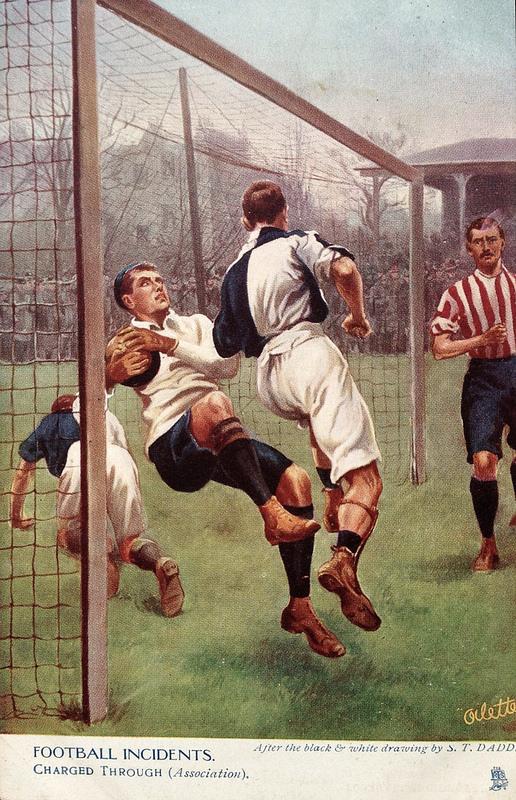
A goalkeeper being charged by a rival player (1905)
Association football, like many sports, has experienced many changes in tactics resulting in the generation and elimination of different positions. Goalkeeper is the only position that is certain to have existed since the codification of the sport. Even in the early days of organised football, when systems were limited or non-existent and the main idea was for all players to attack and defend, teams had a designated member to play as the goalkeeper.
The earliest account of football teams with player positions comes from Richard Mulcaster in 1581 and does not specify goalkeepers. The earliest specific reference to keeping goal comes from Cornish Hurling in 1602. According to Carew: "they pitch two bushes in the ground, some eight or ten foot asunder; and directly against them, ten or twelve score off, other twayne in like distance, which they term their Goals. One of these is appointed by lots, to the one side, and the other to his adverse party. There is assigned for their guard, a couple of their best stopping Hurlers".[13] Other references to scoring goals begin in English literature in the early 16th century; for example, in John Day's play The Blind Beggar of Bethnal Green (performed circa 1600; published 1659): "I'll play a gole at camp-ball" (an extremely violent variety of football, popular in East Anglia). Similarly, in a 1613 poem, Michael Drayton refers to "when the Ball to throw, And drive it to the Gole, in squadrons forth they goe". It seems inevitable that wherever a game has evolved goals, some form of goalkeeping must also be developed. David Wedderburn refers to what has been translated from Latin as to "keep goal" in 1633, though this does not necessarily imply a fixed goalkeeper position.
The word "goal-keeper" is used in the novel Tom Brown's School Days (published in 1857, but set in the 1830s). The author is here referring to an early form of rugby football:
You will see in the first place, that the sixth-form boy, who has the charge of goal, has spread his force (the goal-keepers) so as to occupy the whole space behind the goal-posts, at distances of about five yards apart; a safe and well-kept goal is the foundation of all good play.[14]
The word "goal-keeper" appeared in the Sheffield Rules of 1867, but the term did not refer to a designated player, but rather to "that player on the defending side who for the time being is nearest to his own goal". The goal-keeper, thus defined, did not enjoy any special handling privileges.[15]
The FA's first Laws of the Game of 1863 did not make any special provision for a goalkeeper, with any player being allowed to catch or knock-on the ball.[16] Handling the ball was completely forbidden (for all players) in 1870.[17] The next year, 1871, the laws were amended to introduce the goalkeeper and specify that the keeper was allowed to handle the ball "for the protection of his goal".[18] The restrictions on the ability of the goalkeeper to handle the ball were changed several times in subsequent revisions of the laws:
1871: the keeper may handle the ball only "for the protection of his goal".
1873: the keeper may not "carry" the ball.[19]
1883: the keeper may not carry the ball for more than two steps.[20]
1887: the keeper may not handle the ball in the opposition's half.[21]
1901: the keeper may handle the ball for any purpose (not only in defence of the goal).[22]
1912: the keeper may handle the ball only in the penalty area.
1931: the keeper may take up to four steps (rather than two) while carrying the ball.[23]
1992: the keeper may not handle the ball after it has been deliberately kicked to him/her by a team-mate.
1997: the keeper may not handle the ball for more than six seconds.
Initially, goalkeepers typically played between the goalposts and had limited mobility, except when trying to save opposition shots. Throughout the years, the role of the goalkeeper has evolved, due to the changes in systems of play, to become more active. The goalkeeper is the only player in association football allowed to use their hands to control the ball (other than during throw-ins).
During the 1935-1936 English football season, young Sunderland AFC goalkeeper of the team, Jimmy Thorpe, died as a result of a kick in the head and chest after he had picked up the ball following a backpass in a game against Chelsea at Roker Park. He continued to take part until the match finished, but collapsed at home afterwards and died in hospital four days later from diabetes mellitus and heart failure 'accelerated by the rough usage of the opposing team' [24]his tragic end to Thorpe's career led to a change in the rules, where players were no longer allowed to raise their foot to a goalkeeper when he had control of the ball in his arms.[25]
Due to several time-wasting techniques which were used by goalkeepers, such as bouncing the ball on the ground or throwing it in the air and then catching it again, in the 1960s, the Laws of the game were revised further, and the goalkeeper was given a maximum of four steps to travel while holding, bouncing or throwing the ball in the air and catching it again, without having to release it into play. The FIFA Board later also devised an anti-parrying rule, saying that such deliberate parrying for the purpose of evading the Law was to be regarded also as holding the ball.[26]
In 1992, the International Football Association Board made changes in the laws of the game that affected goalkeepers – notably the back-pass rule,[27] which prohibits goalkeepers from handling the ball when receiving a deliberate pass from a teammate that is made with their feet. This rule change was made to discourage time-wasting and overly defensive play after the 1990 FIFA World Cup which was described as exceedingly dull, rife with back-passing and goalkeepers holding the ball. Also, goalkeepers would frequently drop the ball and dribble it around, only to pick it up again once opponents came closer to put them under pressure, a typical time-wasting technique. Therefore, another rule was introduced at the same time as the back-pass rule. This rule prohibits the goalkeeper from handling the ball again once he or she has released it for play; an offence results in an indirect free kick to the opposition. Furthermore any player negating the spirit of the new rule would be likely to be cautioned for unsporting behaviour and punished by an indirect free-kick.[26]
On 1 July 1997, FIFA decided to extend the back-pass rule by applying it also to throw-ins from defenders to their own goalkeeper; in order to prevent further time-wasting, FIFA also established that if a goalkeeper holds the ball for more than five or six seconds the referee must adjudge this as time-wasting and award an indirect free-kick to the opposing team.[26]
Laws of the Game and general play

Maksym Koval closes down Luis Suárez
The position of goalkeeper is the only position in the game which is technically distinct from the others in the course of normal play. The Laws of the Game distinguish the goalkeeper from the other players in several ways, most significantly exempting them from the prohibition on handling the ball, though only within their own penalty area.[28] Once a goalkeeper has control of the ball in their hands, opponents are not permitted to challenge them.[28] Goalkeepers have a specialised role as the sole defender in penalty kicks and penalty shoot-outs.[28] Goalkeepers are required to wear distinct colours from other players, and are permitted to wear caps and tracksuit bottoms.[28]
The Laws mandate that one player on the team must be designated as the goalkeeper at all times, meaning that if a goalkeeper is sent off or injured and unable to continue another player must assume the goalkeeper position.[28] The Laws allow for teams to change the player designated as goalkeeper at stoppages in play,[28] but in practice this is rarely exercised.
The Laws place no restrictions on a goalkeeper leaving their penalty area and acting as an ordinary player, though generally goalkeepers stay close to their goal throughout the match.
Goalkeepers routinely perform extension dives. To execute this, they push off the ground with the foot nearest to the ball, launching themselves into a horizontal position. At this point, the ball may be caught or parried away from the goal. In the latter case, a good goalkeeper will attempt to ensure that the rebound cannot be taken by a player of the opposing team, although this is not always possible.
Responsibilities
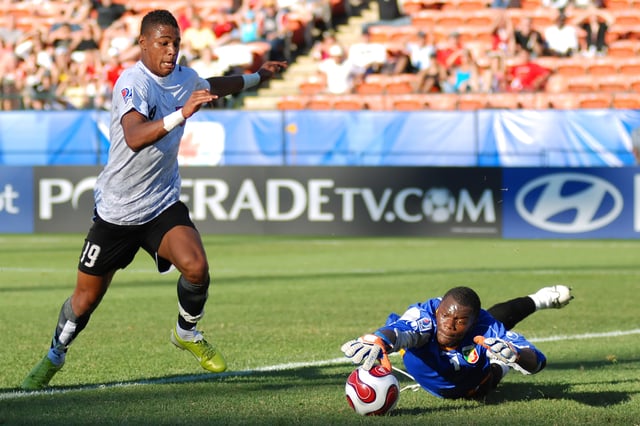
A goalkeeper making a save
The tactical responsibilities of goalkeepers include:
To keep goal by physically blocking attempted shots with any part of their body. The keeper is permitted to play the ball anywhere on the field, but may not handle the ball using hands or outstretched arms outside his/her penalty area.
To organise the team's defenders during defensive set pieces such as free kicks and corners. In the case of free kicks, this includes picking the numbers and the organisation of a defensive man "wall". The wall serves to provide a physical barrier to the incoming ball, but some goalkeepers position their wall in a certain position to tempt the kick-taker to a certain type of shot. Occasionally, goalkeepers may opt to dispense with the wall. Some goalkeepers are also entrusted with the responsibility of picking markers while defending at set pieces.
To pick out crosses and attempted long passes either by collecting them in flight or punching them clear if heavily challenged by opposing strikers.
Although goalkeepers have special privileges, including the ability to handle the ball in the penalty area, they are otherwise subject to the same rules as any other player.
Goalkeepers in playmaking and attack
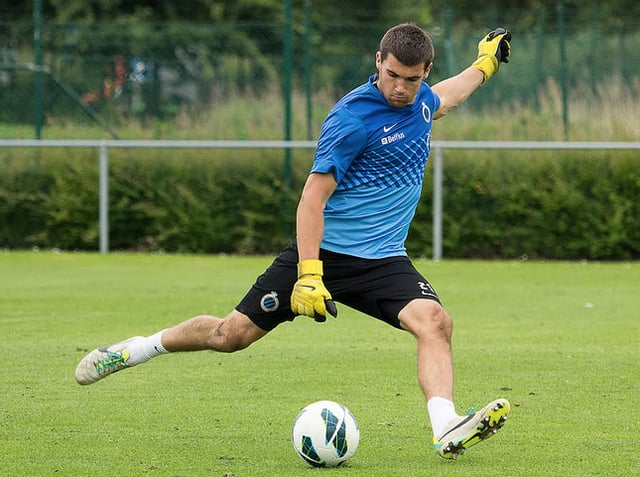
Australian goalkeeper Mathew Ryan[29] playing with his feet.
Goalkeepers are not required to stay in the penalty area; they may get involved in play anywhere on the pitch, and it is common for them to act as an additional defender (or 'sweeper') during certain passages of the game. Goalkeepers with a long throwing range or accurate long-distance kicks may be able to quickly create attacking positions for a team and generate goal-scoring chances from defensive situations, a tactic known as the long ball.
Sweeper-keeper
Gyula Grosics from the Hungary "Golden Team" of the 1950s was thought to be the first goalkeeper to play as the 'sweeper-keeper'.[30] Tommy Lawrence has also been credited with revolutionising the role of the goalkeeper by effectively acting as an 11th outfield player.[31] The rushing playing style used by Liverpool legend Bruce Grobbelaar seen during the 1980s–90s makes him one of the original sweeper-keepers of the modern era.[32] René Higuita was another who became known for his unorthodox, skillful but sometimes reckless techniques.[33] As of 2011, Manuel Neuer has been described as a sweeper-keeper due to his speed and unique style of play which occasionally includes him acting as a sweeper for his team by rushing off his line to anticipate opposing forwards who have beaten the offside trap.[34][35] With his excellent ball control and distribution, which enables him to start plays from the back,[34][35] he has said he could play in the German third division as a centre-back if he wanted to.[36][37] Hugo Lloris of Tottenham Hotspur and France, and former goalkeepers Fabien Barthez and Edwin van der Sar, have also been described as sweeper-keepers,[38][39] while Claudio Bravo and Ederson Moraes of Manchester City have even been described as playmakers in the media.[40][41][42]
Goalscorers

Rogério Ceni is the highest-scoring goalkeeper of all time, with over 100 career goals.
Some goalkeepers have scored goals. Other than by accident when a long kicked clearance reaches the other end of the field and evades the opposing goalkeeper with the aid of strong winds and/or unexpected bounces, this most commonly occurs where a goalkeeper has rushed up to the opposite end of the pitch to give his team a numerical advantage in attack, leaving his own goal undefended. As such, it is normally only done late in a game at set-pieces where the consequences of scoring far outweigh those of conceding a further goal, such as for a team trailing in a knock-out tournament.
Some goalkeepers, such as Higuita, Rogério Ceni, Hans-Jörg Butt and José Luis Chilavert, are also expert set-piece takers. These players may take their team's attacking free kicks or penalties. Ceni, São Paulo's long-time custodian, has scored 100 goals in his career, more than many outfield players.[43][44]
Equipment and attire
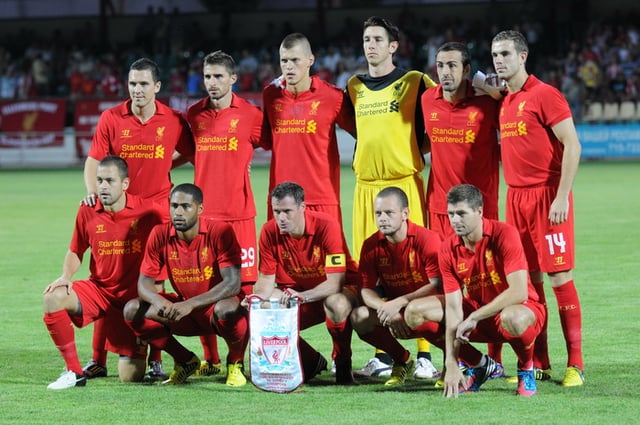
Liverpool F.C. team photo prior to their UEFA Europa League clash against FC Gomel. Note the differing attire of goalkeeper Brad Jones with that of the rest of his teammates.
Goalkeepers must wear kit that distinguishes them clearly from other players and match officials, as this is all that the FIFA Laws of the Game require. Some goalkeepers have received recognition for their match attire, like Lev Yashin of the Soviet Union, who was nicknamed the "Black Spider" for his distinctive all-black outfit;[45][46] Klaus Lindenberger of Austria, who designed his own variation of a clown's costume; Jorge Campos of Mexico, who was popular for his colourful attire;[47] Raul Plassmann of Cruzeiro Esporte Clube and his all-yellow outfit; and Gábor Király for wearing a pair of grey tracksuit bottoms instead of shorts.[48]
Most goalkeepers also wear gloves to improve their grip on the ball, and to protect themselves from injury. Some gloves now include rigid plastic spines down each finger to help prevent injuries such as jammed, fractured, and sprained fingers. Though gloves are not mandatory attire, it is uncommon for goalkeepers to opt against them due to the advantages they offer. At UEFA Euro 2004, Portuguese goalkeeper Ricardo famously took off his gloves during the quarter-final penalty shoot-out against England, knowing he was the next taker for his side. He then went on to save Darius Vassell's penalty using his bare hands before scoring his own kick to win it for Portugal.[53]
Though rare, goalkeepers are permitted to wear visored headgear (such as a baseball cap) to minimize glare from bright sunlight, or a knit cap to insulate from cold weather, at any time if they elect to do so.
Careers and injuries
Because they play a less physically demanding position that requires significantly less running, goalkeepers often have longer playing careers than outfield players, many not retiring until their late thirties or early forties. Notably, Peter Shilton played for thirty-one years between 1966 and 1997 before retiring at the age of forty-seven.
In general, goalkeepers can sustain any injury to which their outfield counterparts are vulnerable. Common lower and upper extremity injuries include cartilage tears, anterior cruciate ligament tears, and knee sprains. On the other hand, goalkeepers rarely fall victim to fatigue-related injuries, such as leg cramps, pulled hamstrings, and dehydration.[56]
Records
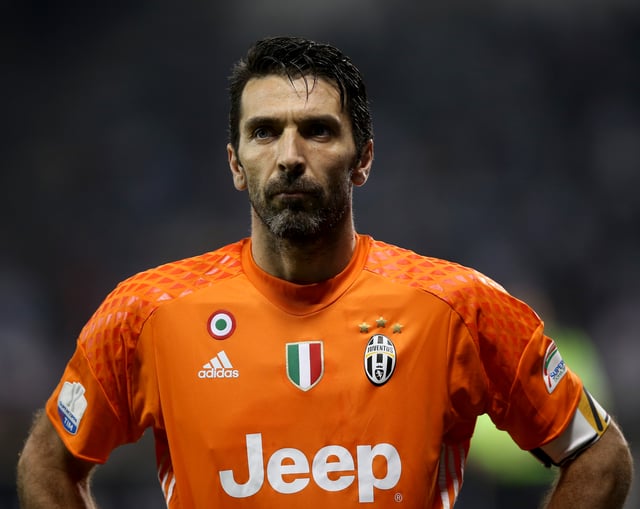
Gianluigi Buffon is the only goalkeeper to have won the UEFA Club Footballer of the Year Award.

Oliver Kahn, the only goalkeeper to win the FIFA World Cup Golden Ball award.
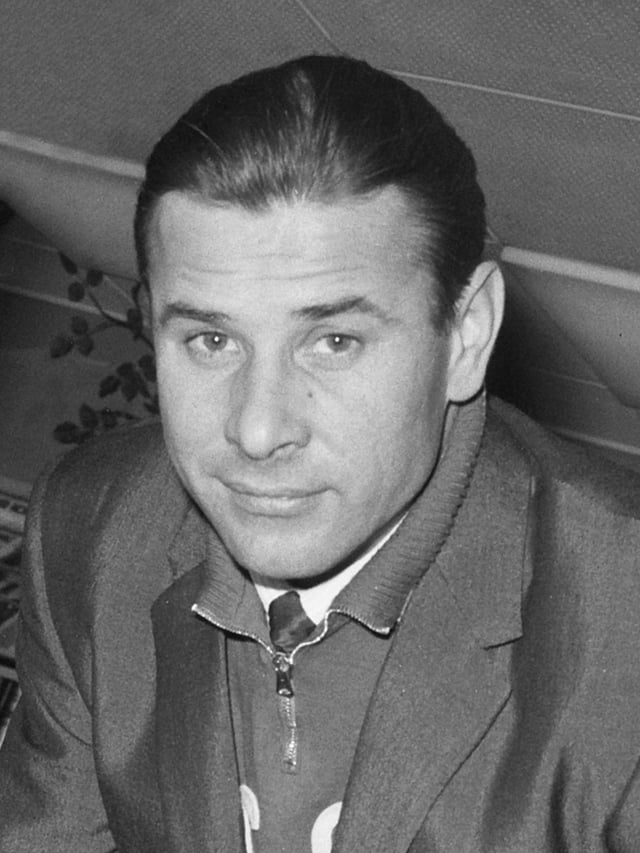
Lev Yashin, the only goalkeeper to win the Ballon d'Or.

Kepa, the world's most expensive goalkeeper, having moved from Athletic to Chelsea for €80 million.
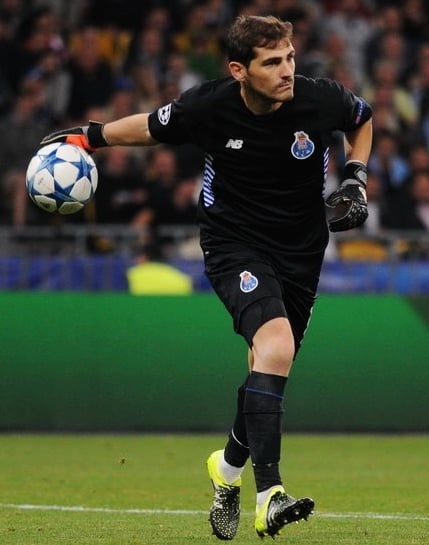
Iker Casillas, the first goalkeeper, male or female, ever to keep one hundred international clean sheets.
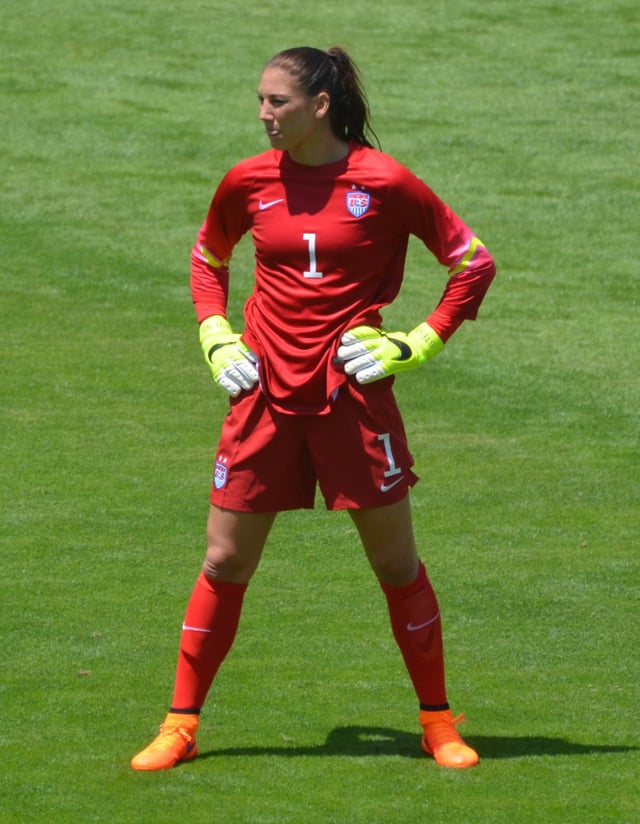
Hope Solo, who shares with Iker Casillas the record for most international clean sheets by any goalkeeper.
Goalkeepers are crucial in penalty shootouts. The record for most penalties saved in a shootout is held by Helmuth Duckadam of Steaua București. Duckadam defended four consecutive penalties in the 1986 European Cup Final against Barcelona.[57] Stefano Tacconi is the only goalkeeper to have won all official club competitions for which he was eligible.[58]
José Luis Chilavert is the only goalkeeper to score a hat-trick (three goals in a game), doing so through penalty kicks. Rogério Ceni has scored the most goals for a goalkeeper, having scored his hundredth goal in official games on 27 March 2011. Ceni scored his goals through free kicks and penalty kicks.[59]
Gianluigi Buffon is the only goalkeeper to have won the UEFA Club Footballer of the Year Award.[60] Oliver Kahn holds the record for most UEFA Best Club Goalkeeper and Best European Goalkeeper Awards with four.[61] Iker Casillas holds the record for most appearances by a goalkeeper in the FIFPro World XI and in the UEFA Team of the Year and most IFFHS World's Best Goalkeeper Awards, alongside Buffon,[62] winning the award for five consecutive years between 2008 and 2012.[63] Casillas holds the record for the most clean sheets in UEFA Champions League history.[64]
At the international level, Dino Zoff has remained unbeaten for the longest period of time,[65] whilst Walter Zenga holds the record for longest unbeaten run in a FIFA World Cup tournament at five hundred seventeen minutes.[66] Gianluigi Buffon, Fabien Barthez and Iker Casillas hold the record for fewest goals conceded by a winning goalkeeper in a World Cup tournament at two each. Buffon is the only World Cup–winning goalkeeper not to have conceded a goal in open play throughout the entire tournament, one goal having resulted from an own goal after a free kick, the other from a penalty. Fabien Barthez and Peter Shilton hold the record for most clean sheets in World Cup matches with ten each Mohamed Al-Deayea holds the record for most international caps by a goalkeeper with one hundred seventy-eight official appearances for Saudi Arabia.[67]
Pascal Zuberbühler holds the record for fewest goals conceded by a goalkeeper in a World Cup tournament and holds the record for most successive matches at an international tournament without conceding a goal with five. He did not concede a goal in four hundred sixty-three minutes of World Cup play against France, Korea, and Togo—making Switzerland the only team in the history of the tournament not to concede a goal in normal time. Tim Howard holds the record for most saves made in a FIFA World Cup match, with sixteen against Belgium in the 2014 Round of 16. Oliver Kahn is the only goalkeeper to have won the Adidas Golden Ball for the best player of the tournament in a World Cup (in the 2002 competition); Lev Yashin is the only goalkeeper to have won the Ballon d'Or. Gianluca Pagliuca of Italy became the first goalkeeper to be sent off in a World Cup Finals match, dismissed for handling outside his area against Norway in 1994. His team went on to win 1–0 and reached the final before losing to Brazil in a penalty shootout, in which he became the first goalkeeper ever to stop a penalty in a final shootout.
Iker Casillas holds both the record for fewest goals conceded in a European Championship with one in 2012) and the record for longest unbeaten run at a European Championship, beating the previous record held by Dino Zoff.[68] He also holds the records for most international clean sheets (one hundred two) by a male goalkeeper, beating the previous record held by Edwin van der Sar (seventy-two), and became the first goalkeeper in history, male or female, to keep one hundred clean sheets at international level in 2015; he also shares the overall record for the most international clean sheets along with Hope Solo.[69][70] Buffon holds the record for most minutes without conceding a goal in European Championship Qualifying matches at six hundred forty-four.[71]
Highest fees
| Player | From | To | Fee (£) | Fee (€) | Year |
|---|---|---|---|---|---|
| £71m | €80m | 2018 | |||
| £66.8m | €75m | 2018 | |||
| £33m | €51.646m[1] | 2001 | |||
| £35m | €40m | 2017 | |||
| £25m[2] | 2017 | ||||
| €28.405m[3] | 2001 | ||||
| £19m | €24m[4] | 2011 | |||
| £19.2m | €22m | 2018 | |||
| £18m | €22m[4] | 2011 | |||
| €20.658m[5] | 2000 | ||||
| €20.658m[6] | 2001 | ||||
| €19m[7] | 2012 | ||||
| €18m[8] | 2016 | ||||
| €17.043m[9] | 2001 | ||||
| £12.6m | €16m | 2014 | |||
| €14.461m[10] | 1999 | ||||
| £10m | €13.9m[4] | 2015 | |||
| £10m | €12.5m[4] | 2014 | |||
| €12.2m[11] | 2017 | ||||
| £9.7m | €12m | 2014 | |||
| £9.7m | €12m[4] | 2014 | |||
| £10m[4] | 2017 | ||||
| £9m[4] | €10.5m | 2013 |
See also
FIFA World Cup All-Star Teams
Golden Glove awards
List of goalscoring goalkeepers
Association football positions
List of most expensive association football transfers
IFFHS World's Best Goalkeeper
Best European Goalkeeper
The Best FIFA Goalkeeper
UEFA Best Club Goalkeeper Award